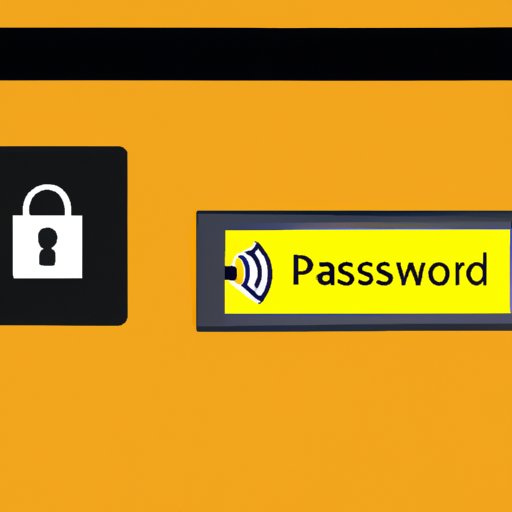I. Introduction
In this digital age, access to the internet has become a necessity for most people. It’s not only essential for work and communication, but also for entertainment and convenience. However, there are times when we forget the wifi password, and it can be frustrating trying to connect to the internet without it. In this article, we will guide you on how to find wifi passwords on Windows and mobile devices, and provide tips, tricks, and tools to keep them safe and organized.
II. How to Find Wifi Password on Windows in 3 Easy Steps
If you’re using a Windows device and have previously connected to a wifi network, you can easily retrieve the password using these three simple steps.
Step 1: Accessing Network and Sharing Center
To start, click on the wifi icon in the bottom right corner of your screen. Then, click on “Network and Sharing Center”.
Step 2: Finding the Network Security Key
Once you’re in the Network and Sharing Center, click on the wifi network you want to retrieve the password for. Then, click on “Wireless Properties” and go to the “Security” tab. You’ll see an option that says “Show characters”. Click on it, and the wifi password will be revealed.
Step 3: Revealing Wifi Password
Alternatively, you can also retrieve the wifi password using the Command Prompt. Simply open the Command Prompt and type “netsh wlan show profile”. This will show all the wifi networks you’ve previously connected to. To retrieve the password for a specific network, type “netsh wlan show profile [network name] key=clear”. The password will be shown under “Key Content”.
III. Unlocking the Wifi Password: Simple Tips and Tricks to Try
If you’ve tried the above steps but still can’t retrieve the wifi password, here are some simple tips and tricks to try.
Checking the Router Label
Most wifi routers have a label on the bottom or the back that contains the wifi password, along with other important information such as the network name and IP address.
Asking a Housemate or Neighbor
If you’re living with others, or have friendly neighbors, don’t hesitate to ask them for the wifi password. Chances are, they would be happy to provide it to you.
Trying Default Passwords
If you’ve recently bought a new wifi router, it usually comes with a default password. You can try looking up the default password online or in the user manual and see if it works.
IV. Never Forget A Wifi Password Again: Effective Strategies to Remember Them All
If you frequently forget your wifi passwords, here are some effective strategies to remember them all.
Use a Password Manager
Password managers are software that help you store and organize your passwords. Simply create an account and add your wifi password to the database. Some popular password managers include LastPass, Dashlane, and 1Password.
Customizing Passwords
Create a system for your passwords that is easy to remember, but difficult for others to guess. For example, you can use a combination of numbers and letters that are meaningful to you, such as birthdays or initials.
Writing it Down
If you prefer a more traditional method, you can write down your wifi passwords in a notebook or on a piece of paper and keep it in a secure location.
V. Discovering Wifi Passwords on Mobile Devices: A Step-by-Step Guide
If you’re using a mobile device such as a phone or tablet and want to retrieve the wifi password, here’s a step-by-step guide.
Android
Open the settings app on your Android device and go to “Network & internet”. Then, click on “Wi-Fi” and select the network you want to retrieve the password for. Click on “Share” and then “QR code”. The wifi password will be shown as a QR code. You can use any QR scanner app to reveal the password.
iOS
Open the settings app on your iPhone or iPad and go to “Wi-Fi”. Click on the network you want to retrieve the password for and select “Share Password”
VI. Hacking Your Own Wifi Password: Why and How to Do It
Hacking your own wifi password may seem counterintuitive, but it’s actually a good way to test your network security and ensure that it’s not vulnerable to outside attacks. Here’s how to do it.
Importance of Testing Network Security
Hackers are always looking for vulnerabilities in wifi networks in order to gain access to personal information or even control connected devices. By testing your own network security, you can identify any weaknesses and take steps to address them before someone else does.
Steps to Hacking Your Own Wifi
To hack your own wifi password, you’ll need a tool such as Aircrack-ng, which can be downloaded for free online. Simply follow the instructions on the website to install the software. Then, launch the software and select the network you want to hack. The software will analyze the network and gather data before attempting to crack the password.
Ethical Considerations
It’s important to note that while hacking your own wifi password is legal, hacking someone else’s password without their consent is illegal and can result in severe consequences. Always ensure that you have authorization before attempting any hacking activities.

VII. Find Wifi Passwords with Command Prompt: A Handy Guide
For those who are comfortable with using the Command Prompt, here’s a handy guide to finding wifi passwords.
Accessing Command Prompt
To access the Command Prompt, simply type “cmd” in the search bar of your Windows device and click on “Command Prompt”.
Using Netsh Command
Once you’re in the Command Prompt, type “netsh wlan show profile”. This will show all the wifi networks you’ve previously connected to. To retrieve the password for a specific network, type “netsh wlan show profile [network name] key=clear”. The password will be shown under “Key Content”.
Finding Password from Encrypted Key
If the above step doesn’t work, try typing “netsh wlan export profile key=clear”. This will export all the wifi profiles on the computer in an XML file. You can then open the XML file with a text editor and find the wifi password within the profile.
VIII. Managing Your Wifi Passwords: Best Practices and Tools to Keep Them Safe and Organized
Now that you’ve learned how to find and remember your wifi passwords, it’s important to keep them safe and organized. Here are some best practices and tools to help you do that.
Use a Password Manager
As mentioned earlier, password managers are a great way to store and organize your wifi passwords. They also have added security features such as two-factor authentication and password encryption.
Create Complex Passwords
To ensure maximum security, create complex and unique passwords for each of your wifi networks. This will make it difficult for hackers to guess the password using brute force attacks.
Regularly Change Passwords
Lastly, it’s important to regularly change your wifi passwords to prevent any unauthorized access. Set a reminder to update your passwords every six months or so.
IX. Conclusion
In conclusion, we hope this article has provided helpful tips and tricks for finding and remembering your wifi passwords on Windows and mobile devices. We’ve covered everything from accessing your network and sharing center, to hacking your own wifi password, and managing your passwords safely. Remember to always prioritize network security and use tools such as password managers to keep your wifi passwords safe and organized.
Final Thoughts
As technology continues to evolve, so do the methods of accessing and protecting our digital information. Staying informed and up-to-date with the latest strategies and tools is essential for a safe and seamless online experience.
Call to Action
Don’t forget to share this article with friends and family who might find it helpful.
